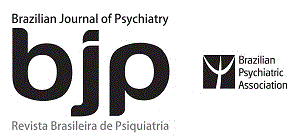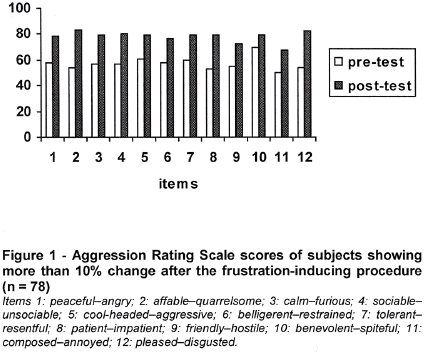Abstracts
OBJECTIVE: To test a reliable and easily administered frustration-induction procedure for experimental research. METHOD: One hundred volunteers (81 women, mean age ± SD 34.2 ± 8 years) physically and psychiatrically healthy submitted to the frustration induction procedure were prevented from reaching reward level scores. Subjective aggressiveness feelings related to frustration were self-rated in a 13-item visual analogue scale before and after the procedure. RESULTS: Significant increases in aggressiveness-related feelings were detected in 12 of the 13 items. This was consistent with the observed overt behavior of the subjects during the task. CONCLUSIONS: The frustration-induction procedure is a simple, easy to administer frustration-induction procedure that can be used in experimental studies in normal subjects.
Evaluations studies; Expressed emotion; Emotions; Frustration; Irritability
OBJETIVO: Testar um procedimento de indução de frustração confiável e de simples aplicação para a pesquisa experimental. MÉTODO: Cem voluntários (81 mulheres, idade média ± DP 34,2 ± 8 anos), física e psiquiatricamente saudáveis, submetidos ao procedimento de indução de frustração, foram impedidos de atingir escores de recompensa. Os sentimentos de agressividade subjetivos relacionados à frustração foram autoclassificados em um escala analógica visual de 13 itens antes e após o procedimento. RESULTADOS: Foram detectados aumentos significativos nos sentimentos relacionados à agressividade em 12 dos 13 itens. Isto foi consistente com o comportamento manifestado pelos indivíduos e observado durante a tarefa. CONCLUSÕES: O procedimento de indução de frustração é simples, facilmente aplicável e que pode ser utilizado em estudos experimentais com indivíduos normais.
Estudos de avaliação; Emoções manifestas; Emoções; Frustração; Irritabilidade
BRIEF REPORT
Validity of a frustrationinduction procedure
Validade de um procedimento para indução de frustração
Elaine HennaI; Monica L ZilbermanI; Valentim GentilI; Clarice GorensteinII
ILaboratory of Psychopharmacology, Institute and Department of Psychiatry, Universidade de São Paulo Medical School (USP), São Paulo (SP), Brazil
IIDepartment of Pharmacology, Institute of Biomedical Sciences, Universidade de São Paulo (USP), São Paulo (SP), Brazil
Correnpondence
ABSTRACT
OBJECTIVE: To test a reliable and easily administered frustrationinduction procedure for experimental research.
METHOD: One hundred volunteers (81 women, mean age ± SD 34.2 ± 8 years) physically and psychiatrically healthy submitted to the frustration induction procedure were prevented from reaching reward level scores. Subjective aggressiveness feelings related to frustration were selfrated in a 13item visual analogue scale before and after the procedure.
RESULTS: Significant increases in aggressivenessrelated feelings were detected in 12 of the 13 items. This was consistent with the observed overt behavior of the subjects during the task.
CONCLUSIONS: The frustrationinduction procedure is a simple, easy to administer frustrationinduction procedure that can be used in experimental studies in normal subjects.
Descriptors: Evaluations studies; Expressed emotion; Emotions; Frustration; Irritability
RESUMO
OBJETIVO: Testar um procedimento de indução de frustração confiável e de simples aplicação para a pesquisa experimental.
MÉTODO: Cem voluntários (81 mulheres, idade média ± DP 34,2 ± 8 anos), física e psiquiatricamente saudáveis, submetidos ao procedimento de indução de frustração, foram impedidos de atingir escores de recompensa. Os sentimentos de agressividade subjetivos relacionados à frustração foram autoclassificados em um escala analógica visual de 13 itens antes e após o procedimento.
RESULTADOS: Foram detectados aumentos significativos nos sentimentos relacionados à agressividade em 12 dos 13 itens. Isto foi consistente com o comportamento manifestado pelos indivíduos e observado durante a tarefa.
CONCLUSÕES: O procedimento de indução de frustração é simples, facilmente aplicável e que pode ser utilizado em estudos experimentais com indivíduos normais.
Descritores: Estudos de avaliação; Emoções manifestas; Emoções;Frustração; Irritabilidade
Introduction
Experimental models of induced emotions have long been used to study their behavioral and physiological correlates and treatment efficacy. The development of reliable methods to elicit emotional states such as sadness, happiness, anxiety, anger, disgust, and fear became particularly important following the development of functional neuroimaging.
The procedures most frequently employed for the eliciation of emotions include the recall of prior experiences through narrative autobiographical scripts;1 the exhibition of emotionallyladen films, and the exposure to standardized human faces or pictures;2 the administration of demanding mathematical tasks;3 simulated public speaking tasks;4 and pharmacological challenge procedures. Their efficiency, validity and specificity to induce a target emotion vary according to which procedure is used.5
The aim of the present study is to test a simple and easilyadministered frustrationinduction procedure (FIP) to be used in studies with normal subjects.
Method
1. Subjects
One hundred volunteers (81 women, mean age ± SD = 34.2 ± 8 years) who entered in a psychopharmacological study6 (n = 70; 58 women, 33.2 ± 1.2 years) or who were recruited among users of a fitness centre (n = 30; 23 women, 36.8 ± 11.3 years) took part in this task. They were considered physically and psychiatrically healthy according to a psychiatric screening questionnaire (SRQ)7 followed by a structured psychiatric interview (SCID)8 and by physical and laboratory examinations. All subjects signed informed consent forms, and the study was approved by the Ethics Committee of the Hospital das Clínicas of the Medical School of the Universidade de São Paulo (CAPPesq 048/01).
2. Frustrationinducing procedure (FIP) development
A sequence of 4 cards from a deck of 64 numbered from 1 to 4, in 4 suits (spades, clubs, diamonds, and hearts) and with 4 colors (red, green, blue, and black) was presented to be sorted by the subjects according to a rule (color, number or suit). They were told they would win a box of chocolate, kept in front of the subjects, upon correctly sorting 10 consecutive combinations. During the test, any combination proposed by the subject was accepted as correct, except the 10th which was always considered wrong, thus precluding success.
The FIP, based on Wisconsin Card Sorting Test (WCST),9 was tested in a pilot study on 10 subjects and seemed to reliably induce irritability. At the end of testing, participants reported subjective feelings of mild anger, frustration, impatience, annoyance, and irritability.
3. Instruments
The Aggression Rating Scale (ARS)10 consisting of 13 bipolar visual analogue scales measuring feelings related to irritability, anger, and aggressiveness was applied before and after the procedure.
4. Statistical analysis
Subjects were tested for homogeneity regarding sex (Chi Square) and age and performance variability (ANOVA). Pairedsample ttests were performed to compare means before and after FIP application. A significance level of 5% was adopted.
Results
There was no effect of sex, age, and site of recruitment on the subjects performance. With the exception of "rebelliouscompliant", the rating of all items showed significant differences after the frustrationinduced procedure. Subjects evaluated themselves as less peaceful, affable, calm, sociable, coolheaded, restrained, tolerant, patient, friendly, benevolent, composed and pleased than before the procedure.
Data inspection revealed that nearly 20% of the subjects presented minimal changes in the visual analogue scale scores (less than 10%), and were excluded. Figure 1 displays the results after exclusion of the nonresponsive subjects.
The efficacy of the procedure was consistent with the behavior of the subjects during the test: most of them were restless, tapped their fingers, or displayed annoyed facial expression.
Discussion
Strategies to induce irritability, hostility, aggressiveness, and anger employ competitive reactiontime tasks,10 autobiographical sketches, unsolvable maze tasks,11 and successfailure manipulations.12 The frustrationinducing paradigms, in which subjects are prevented from receiving a promised reward, are easier to set up than other methods.13 On the other hand, the effectiveness of successfailure manipulations in inducing frustration depends on the subject realizing that he is not the one responsible for the failure, otherwise other feelings such as guilt or shame may be evoked.14
The FIP was able to induce irritability in approximately 80% of our subjects. This was patent in 12 out of 13 items of the Aggression Rating Scale. Accordingly, subjective ratings of irritability were consistent with the subjects overt behavior.
The fact that the subjects were not aware of the objectives of the procedure (namely, to induce irritability) and did not argue that the investigator might be manipulating the task is relevant, since the effectiveness of other paradigms, such as recall of autobiographical memories and emotion induction by pictures, music or movies may be influenced by the socalled demand effect.10 This effect consists of subjects not really achieving the desired emotional state but simply trying to please the investigator reporting what they guess to be the purpose of the study.
These results are not explained by a biased selection of pronetoirritability subjects, since a subsample of 70 subjects answer the personality quetionnaire scored within the normal range in all factors of the Temperament and Character Inventory.15 Hence, they were not particularly impulsive or aggressive at baseline.
In conclusion, the FIP proved to be a simple, reliable and expedite procedure to elicit irritability, taking less than 15 minutes to be administered. The usefulness of these results for psychopharmacological and emotion research should be confirmed in larger samples. Also, it should be tested in studies comparing different samples including patients with psychiatric disorders and healthy subjects.
Acknowledgment
Authors thank Daniel Fuentes for helpful suggestions.
Submitted: May 7, 2007
Accepted: June 5, 2007
Correspondence
Clarice Gorenstein
LIM23, Rua Dr Ovidio Pires de Campos, 785
05403010 São Paulo, SP, Brazil
Phone/Fax: (55 11) 30696958
Email: cgorenst@usp.br
Financing: Fundação de Amparo à Pesquisa do Estado de São Paulo (FAPESP proc. No. 01/001899)
Conflict of interests: None
Study carried out at the Institute of Psychiatry, Hospital das Clínicas, Universidade de São Paulo Medical School (USP), São Paulo (SP), Brazil.
- 1. Mayberg HS, Liotti M, Brannan SK, McGinnis S, Mahurin RK, Jerabek PA, Silva JA, Martin CC, Lancaster JL, Fox PT. Reciprocal limbiccortical function and negative mood: converging PET findings in depression and normal sadness. Am J Psychiatry 1999;156(5):67582.
- 2. Smith JC, Bradley MM, Lang PJ. State anxiety and affective physiology: effects of sustained exposure to affective pictures. Biol Psychol 2005;69(3):24760.
- 3. Naliboff BD, Benton D, Solomon GF, Morley JE, Fahey JL, Bloon ET, Makinodan T, Gilmore SL. Immunological changes in young and old adults during brief laboratory stress. Psychosom Med 1991;53(2):12132.
- 4. Guimaraes FS, Kohem CL, Gus G, Fillmann HS, deVecino MC, dePaoli CL, Ribeiro AM, Teixeira CC, Wannmacher L. A simple simulated public speaking test for evaluating anxiolytic drugs. Braz J Med Biol Res 1989;22(9):10839.
- 5. Westermann R, Spies K, Stahl G, Hesse FW. Relative effectiveness and validity of mood induction procedures: a metaanalyses. Eur J Soc Psychol 1996;26:55780.
- 6. Gentil V, Zilberman ML, Lobo D, Henna E, Moreno R A, Gorenstein C. Clomipramine induced mood and perceived performance changes in selected healthy individuals. J Clin Psychopharmacol. 2007;27(3):3145.
- 7. Harding TW, Arango MV, Baltazar J, Climent CE, Ibrahim HH, LadridoIgnacio L, Murthy RS, Wig NN. Mental disorders in primary health care: a study of their frequency and diagnosis in four developing countries. Psychol Med 1980;10(2):23141.
- 8. Spitzer RL, Williams JB, Giboon M, First MB. The Structured Clinical Interview for DSMIIIR (SCID). I: history, rationale and description. Arch Gen Psychiatry 1992;49(8):6249.
- 9. Heaton RK, Chelune JG, Talley JL, Kay GG, Curtiss G. Wisconsin Card Sorting Test Manual Revised and Expanded Odessa: Psychological Assessment Resources, Inc.; 1993.
- 10. Bond A, Lader M. A method to elicit aggressive feelings and behaviours via provocation. Biol Psychol 1986;22(1):6979.
- 11 Cemalcilar Z, Canbeyli R, Sunar D. Learned helplessness, therapy, and personality traits: an experimental study. J Soc Psychol 2003;143(1):6581.
- 12. Weiner B. Role of success and failure in the learning of easy and complex tasks. J Pers Soc Psychol 1966;3(3):33944.
- 13. Nummenmaa L, Niemi P. Inducing affective states with successfailure manipulations: a metaanalysis. Emotion 2004;4(2):20714.
- 14. Roseman IJ. Appraisal determinants of discrete emotions. Cogn Emot 1991;5:161200.
- 15. Cloninger CR, Svrakic DM, Przybeck TR. A psychobiological model of temperament and character. Arch Gen Psychiatry 1993;50(12):97590.
Publication Dates
-
Publication in this collection
13 Aug 2007 -
Date of issue
Mar 2008
History
-
Received
07 May 2007 -
Accepted
05 June 2007


